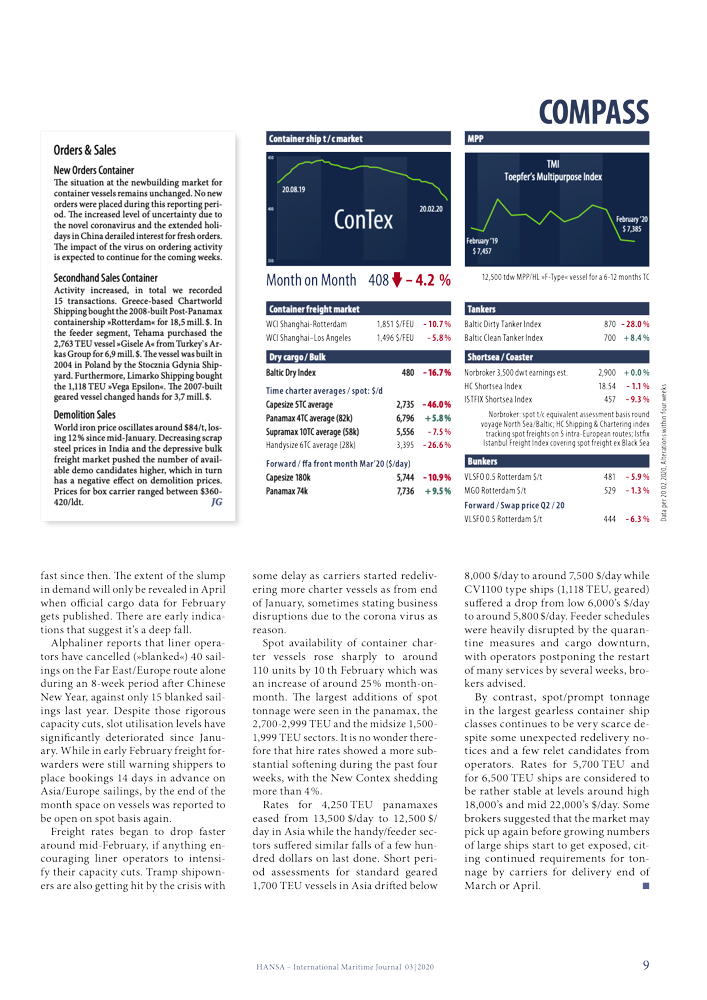Curbs on production and transport in China aimed at containing the corona virus have caused steep falls in freights and charter rates across the dry and wet cargo sectors.
Market fundamentals in shipping are undergoing a major reshaping as containment measures in China – and other countries including Singapore and[ds_preview] South Korea – against the rampant corona virus are strangling economic and logistical activities in the east. The resultant falls in commodity demand have dragged down vessel earnings in the dry, container ship and tanker sectors and might depress trading for several more weeks or even months to come.
Analysts and economists expect a heavy reduction in GDP growth in China during the first quarter and perhaps also the second quarter, slashing full-year growth in the world’s second-largest economy to around 5.4-5.6% – down from 6.1% in 2019. Alphaliner expects a sharp reduction in container port throughput in China to the tune of 6 mill. TEU in the first quarter. Full-year container handling growth worldwide would thus be curtailed by 0.7 percentage points or more to just 1-2% and well below expected fleet growth of over 3.0%.
In the dry bulk trades, iron ore shipping volumes into China are expected to decline this year which will be difficult to counter-balance given the dominance of China seaborne iron ore in dry bulk shipping today. The consequences for crude tankers will be no less severe, with the International Energy Agency IEA forecasting the first quarterly drop in global oil demand during Q1 (-435,000 bpd).
Dry Bulk first to collapse
Due to the combined effect of the seasonal »Chinese New Year« lull and large-scale quarantine measures shipping markets already plunged to rock-
bottom levels (or close …) over the past weeks. Global dry bulk shipping was the first to collapse but seems to have bottomed out while the pressure on container-related markets still keeps building. Crude tanker earnings are flatlining at low levels after collapsing during January.
The question is how much longer shipowners and operators will have to wait for volumes and for rates to pick up again. All experts agree that there is going to be a significant rebound in economic activity once the health crisis is contained or resolved. However, the strength of the rebound and its timing are posing a conundrum to economists and analysts.
International shipping body BIMCO is studying two likely scenarios which would see a recovery of economic life in China by April/May at the latest, meaning that shipping could see a return to normal activity levels perhaps as early as the beginning of the second quarter. The mood in the dry bulk futures market seems to support that view as illustrated by surging prices for Q2 contracts on the time charter averages.
As HANSA went to press, Q2 average rates were trading at 11,300 $/day (versus $4,364 for Q1) for capesize vessels, at 11,627 $/day (versus 7,456 $/day in Q1) for panamaxes, at 9,696 $/day versus 6,650$ for supramaxes and at 6,800 $/day versus 4,588 $/day (Q1) for 28,000 dwt handysize bulkers.
The US Department of Agriculture (USDA) forecasts notable increases in Brazilian soyabean exports and soyameal liftings ex Argentinia for the 2019/20 marketing year (October-September) which would particularly benefit panamaxes and smaller geared bulkers.
There are also silver linings for capesize carriers despite the more muted outlook for the steel and iron ore complex in China due to the negative effects of labour shortages and curbs on inland transportation on production. London shipbroker SSY has highlighted longhaul coal trades from the Atlantic to China as a positive driver for ton mile demand for large vessels this year.
The combination of lower FOB prices for Atlantic coals due to lacklustre demand from Europe and reduced freight rates had sparked increased capesize chartering activity for coal cargoes ex Columbia to China and to India this year, it said.
Cargo volumes dwindling fast
By contrast, in container shipping the impact of the corona virus continues to grow. Liner shipping started the year with fairly high load factors on trades ex Far East ahead of Chinese New Year, but cargo volumes have been dwindling fast since then. The extent of the slump in demand will only be revealed in April when official cargo data for February gets published. There are early indications that suggest it’s a deep fall.
Alphaliner reports that liner operators have cancelled (»blanked«) 40 sailings on the Far East/Europe route alone during an 8-week period after Chinese New Year, against only 15 blanked sailings last year. Despite those rigorous capacity cuts, slot utilisation levels have significantly deteriorated since January. While in early February freight forwarders were still warning shippers to place bookings 14 days in advance on Asia/Europe sailings, by the end of the month space on vessels was reported to be open on spot basis again.
Freight rates began to drop faster around mid-February, if anything encouraging liner operators to intensify their capacity cuts. Tramp shipowners are also getting hit by the crisis with some delay as carriers started redelivering more charter vessels as from end of January, sometimes stating business disruptions due to the corona virus as reason.
Spot availability of container charter vessels rose sharply to around 110 units by 10th February which was an increase of around 25% month-on-month. The largest additions of spot tonnage were seen in the panamax, the 2,700-2,999TEU and the midsize 1,500-1,999TEU sectors. It is no wonder therefore that hire rates showed a more substantial softening during the past four weeks, with the New Contex shedding more than 4%.
Rates for 4,250TEU panamaxes eased from 13,500$/day to 12,500$/day in Asia while the handy/feeder sectors suffered similar falls of a few hundred dollars on last done. Short period assessments for standard geared 1,700TEU vessels in Asia drifted below 8,000$/day to around 7,500$/day while CV1100 type ships (1,118TEU, geared) suffered a drop from low 6,000’s $/day to around 5,800 $/day. Feeder schedules were heavily disrupted by the quarantine measures and cargo downturn, with operators postponing the restart of many services by several weeks, brokers advised.
By contrast, spot/prompt tonnage in the largest gearless container ship classes continues to be very scarce despite some unexpected redelivery notices and a few relet candidates from operators. Rates for 5,700TEU and for 6,500TEU ships are considered to be rather stable at levels around high 18,000’s and mid 22,000’s $/day. Some brokers suggested that the market may pick up again before growing numbers of large ships start to get exposed, citing continued requirements for tonnage by carriers for delivery end of March or April.
Michael Hollmann





















